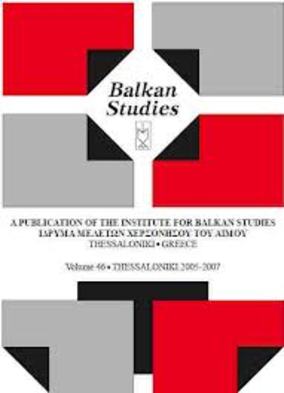Un manuscrit de Dionisie eclisiarhul au monastere de barlaam
Part of : Balkan studies : biannual publication of the Institute for Balkan Studies ; Vol.23, No.2, 1982, pages 307-319
Issue:
Pages:
307-319
Parallel Title:
A manuscript of Dionisie eclesiarhul at the Barlaam monastery, Meteora
Section Title:
Articles
Author:
Abstract:
In the early thirties Marcu Beza discovered at the Barlaam Monastery/ Meteora a Romanian manuscript, which he described in hisbook Romanian Traces in the Orthodox Orient. The brief descriptionwas accompanied by four photographs.The manuscript, an abridged register of the Bucovät Monastery(Oltenia), is adorned with miniatures, among which two full-page compositionsdeserve particular attention: Saint Nicholas, patron of theRomanian monastery, and All Saints’, dedication of the Barlaam Monastery.In 1934 N. lorga published the text of the documents containedin the Barlaam register. They represent a choice of charters, reconfirmingthe monastic properties at different times. The Bucovät Monasterywas founded in 1572 and submitted to Barlaam in 1588.A. Sacerdoteanu, an experienced archivist, was the first to suggest(1967) that the Barlaam manuscript could belong to DionisieEclesiarhul, an outstanding Wallachian chronicler, calligrapher and miniaturistof the late 18th and early 19th centuries. His suggestion wasbased exclusively on the textual analysis, using the lorga transliterationas a starting point.The full version of the Bucova( register is preserved at the StateArchives, Bucharest (ms. no. 443). It bears Dionisie’s signature andthe date (1813). The decorative and the palaeographic similarities betweenthe Bucharest and the Barlaam manuscripts are obvious. Theirtitle pages and Saint Nicholas miniatures display even a certain identityof details. Further comparative material is offered by the obituary of theBucovät Monastery (State Archives, Bucharest, ms. no. 460). The manuscriptis signed by Dionisie and dates from 1813 as well.The page-setting, the graphic characteristics and the decorationreveal Dionisie as compiler, calligrapher and illustrator of the BarlaamRomanian manuscript, written probably at the same time with theother two Dionisie / Bucovät manuscripts (1813). As an abstract of the original register, the Barlaam short versionwas destined to be kept at the patron monastery. The figuration ofthe All Saints’scene besides that of Saint Nicholas points out the adhoc destination of the Barlaam manuscript. Its function was morerepresentative than purely documental.The dedication of the Barlaam Monastery furnishes the best explanationfor the presence of the All Saints’ scene among the wall paintingsfrom the naos of the Bucovät church. This infrequent scene occupiesa prominent place in the naos, namely the half-dome of thesouth apse.
Subject:
Subject (LC):
Notes:
Στο τέλους του άρθρου υπάρχουν εικόνες (χωρίς αριθμημένες σελίδες).




